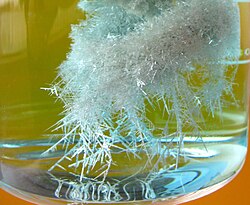Metal tree
A metal tree is a tree-like, branched structure made of metal that is created when the metal is deposited under suitable conditions from a solution of a corresponding salt. In general, such branched structures are also called dendritic .
Historical
Diderot attributed the first publication on metal trees to the Greek chemist Carasses Rhodes - published in the Journal des Savants in 1677. Antoine Furetière had observed corresponding experiments on growth with the shape of a tree for various metals (gold, silver, iron and copper). The first publication was also ascribed to Athanasius Kircher in his book Mundus Subterraneus (1660); but he is not considered to be the discoverer of the experiment he described. The metal trees led to discussions about the extent to which the mineral world is alive.
As early as 1821, the formation of metal trees and metal deposition had been studied in more detail, and the metals could be classified according to their more or less noble character.
Historical names
The metal trees discovered in the 17th century were named with the Latin word for tree, arbor, and a name for the metal from the alchemical period. This is how the following names came about:
- Pewter tree: Arbor Jovis
- Lead tree: Arbor Saturni , Saturn tree preferably obtained from a lead acetate solution with a zinc rod
- Silver tree : Arbor Dianae
- Eisenbaum: Arbor Martis , obtained by reducing an iron solution with tartaric acid
- Copper tree: Arbor Veneris
Today's meaning
The cultivation of metal trees - including copper and zinc trees - can be used to differentiate between more or less noble metals and to demonstrate the electrochemical series.
Literature and individual references
- ↑ a b Karl Wilhelm Gottlob Kastner: Ground plan of experimental physics. tape 2 . Mohr and Winter, Heidelberg 1821, p. 52 .
- ^ Johann Samuel Traugott Gehler (Ed.): Johann Samuel Traugott Gehler's Physical Dictionary VI. Volume Third Section Me-My. reworked by Brandes. Gmelin. Littrow. Muncke. Pfaff. tape 6 . EB Schwickert, Leipzig 1837, p. 1815 ( pages 1814–1815 with the entry "Metallbaum" on the pages of the Open Library of the Internet Archive [accessed on September 4, 2013]).
- ↑ lemmi: Bleibaum . ( Illustrated instructions for making a lead tree and pictures of the tree on the website of Illumina-Chemie.de [accessed on September 6, 2013] as a PDF file 1220 kB ).
- ↑ Marco Oetken: The tension series of metals "small but fine" - aesthetics in the microcosm . ( Growing metal trees to demonstrate the series of voltages, PDF file, 149 kB [accessed on September 6, 2013]).
